Reminiscing
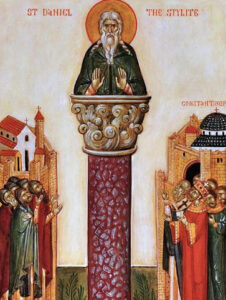
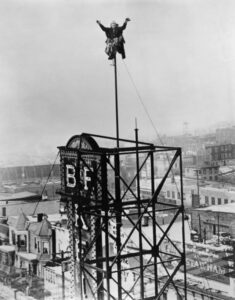 As its name indicated, “pole sitting is the practice of sitting on top of a pole (such as a flagpole) for extended lengths of time, generally used as a test of endurance.” When you first hear the words, it might generate a picture in your mind of someone trying to sit on the little ball that is on top of most flag poles, but actually, a small platform was typically placed at the top of the pole for the sitter…thankfully. The 1920s fad originated with stunt actor and former sailor Alvin “Shipwreck” Kelly, and it became a fad in the mid-to-late 1920s, but mostly died out after the start of the Great Depression. I suppose that during the Great Depression, there just didn’t seem to be an interest in silliness like that.
As its name indicated, “pole sitting is the practice of sitting on top of a pole (such as a flagpole) for extended lengths of time, generally used as a test of endurance.” When you first hear the words, it might generate a picture in your mind of someone trying to sit on the little ball that is on top of most flag poles, but actually, a small platform was typically placed at the top of the pole for the sitter…thankfully. The 1920s fad originated with stunt actor and former sailor Alvin “Shipwreck” Kelly, and it became a fad in the mid-to-late 1920s, but mostly died out after the start of the Great Depression. I suppose that during the Great Depression, there just didn’t seem to be an interest in silliness like that.
Pole sitting is actually a much older practice than you might think. It was predated by the ancient ascetic discipline of stylitism, which is basically column-sitting. Saint Simeon Stylites the Elder, who lived about 388–459, of Antioch (now Turkey) was a column-sitter who sat on a small platform on a column for 36 years. Why??? I don’t understand the purpose of something like that…at least not in that era. These days it is most likely a way of setting some outlandish record. It seems that getting into the Guiness Book of World Records is a great way of obtaining some recognition.
It seems that something like that was the idea, when 14-year-old William Ruppert broke the pole sitting record of 23 days, in 1929. “Shipwreck” Kelly’s initial 1924 sit lasted 13 hours and 13 minutes. It soon became a big fad with other contestants setting records of 12, 17, and 21 days. In 1929, “Shipwreck” Kelly decided to reclaim the title. He sat on a flagpole for 49 days in Atlantic City, New Jersey, setting a new record. As with all records, the race to top it was on, and the following year, 1930, his record was broken by Bill Penfield in Strawberry Point, Iowa, who sat on a flagpole for 51 days and 20 hours, until a thunderstorm forced him down. Let’s face it while sitting on a pole to break a record was a “fun” idea, it was not something they were willing to lose their lives over. For the most part, pole sitting was confined to the 1920s, ending start of the Depression.
Then, a 37-year-old Ohio resident named Marshall Jacobs, who was trying to revive the fad, married his fiancée Yolanda Cosmar atop a flagpole with a roost in 1946. A wedding photograph of them kissing gained wide attention. In 1949, Cleveland resident Charley Lupica sat atop a flagpole platform for 117 days, to support the Cleveland Indians in their pennant race against the New York Yankees. A serious fan of the Cleveland Indians, Lupica, after an argument with Yankees fans, began sitting on a flagpole above his grocery store on May 31. He claimed he would stay on the pole until the Indians either claimed first place in the standings or were eliminated from contention. Unfortunately for him, the Indians never passed the Yankees, and Lupica came down during the Indian’s final home game on September 25. Indians owner Bill Veeck had moved Lupica and the flagpole to Cleveland Municipal Stadium the night before as a promotional stunt. Richard “Dixie” Blandy claimed various records as champion at 77, 78 between 1933 to 1963. Then, he sat 125 days until he died on May 6, 1974, in Harvey, Illinois when the 50 feet pole on which he was sitting collapsed. Peggy (Townsend) Clark set a record of 217 days in 1964 in Gadsden, Alabama. Pole sitting was also used for other things. From November 1982 to January 21, 1984, a total of 439 days, 11 hours, and 6 minutes, H David Werder sat on a 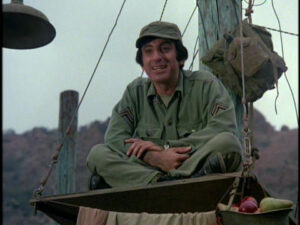
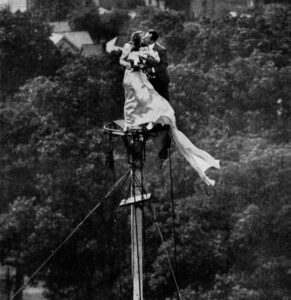 pole to protest against the price of gasoline. The game show “What’s My Line” hosted by John Charles Daly, got in on the action when a flagpole sitter is the first guest on the July 3, 1955, episode. It even came into the television show, M*A*S*H, when everyone got in on the fun, encouraging Klinger to stick it out, including Colonel Potter learns that the Army record for pole sitting is 96 hours. Potter turned the tables on Klinger by convincing him to stay up there to break the record. Finally, it died out again, unless someone else decides to pick it up again.
pole to protest against the price of gasoline. The game show “What’s My Line” hosted by John Charles Daly, got in on the action when a flagpole sitter is the first guest on the July 3, 1955, episode. It even came into the television show, M*A*S*H, when everyone got in on the fun, encouraging Klinger to stick it out, including Colonel Potter learns that the Army record for pole sitting is 96 hours. Potter turned the tables on Klinger by convincing him to stay up there to break the record. Finally, it died out again, unless someone else decides to pick it up again.
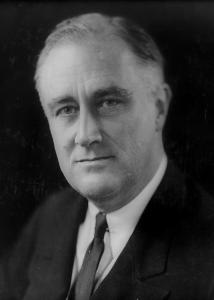
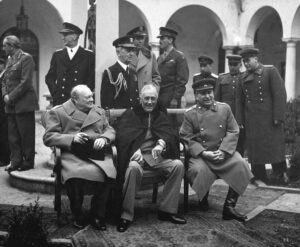 What was known as the Yalta Conference, was held February 4 – 11, 1945. It was a meeting of the heads of government of the United States, the United Kingdom, and the Soviet Union, during World War II, to discuss the postwar reorganization of Germany and Europe, because it was becoming more and more evident that the war was winding down, and the Allies would be the victors. Representing the United States was President Franklin D Roosevelt. Prime Minister Winston Churchill represented the United Kingdom, and the Soviet Union was represented by General Secretary Joseph Stalin. Yalta is located in Crimea, Soviet Union, within the Livadia, Yusupov, and Vorontsov palaces.
What was known as the Yalta Conference, was held February 4 – 11, 1945. It was a meeting of the heads of government of the United States, the United Kingdom, and the Soviet Union, during World War II, to discuss the postwar reorganization of Germany and Europe, because it was becoming more and more evident that the war was winding down, and the Allies would be the victors. Representing the United States was President Franklin D Roosevelt. Prime Minister Winston Churchill represented the United Kingdom, and the Soviet Union was represented by General Secretary Joseph Stalin. Yalta is located in Crimea, Soviet Union, within the Livadia, Yusupov, and Vorontsov palaces.
As a war comes to a close, there must be some kind of a postwar strategy for shaping how the defeated nation will move into peacetime. They cannot be allowed to continue in the same direction that led to war in the first place, and the nations who won the victory will be key players in the newly formed alliance. They needed to shape a postwar peace that represented not only a collective security order, but also a plan to give self-determination to the liberated peoples of Europe, following years of oppression. The conference was intended mainly to discuss the re-establishment of the nations of war-torn Europe. Unfortunately, within a few years, and with the Cold War dividing the continent, the conference became a subject of intense controversy. There was a total of three conferences during World War II. They were known as the Big Three, and Yalta was the second one. The first was the Tehran Conference in November 1943 and the third was the Potsdam Conference in July of the same year as the Yalta Conference…1945. It was also preceded by a conference in Moscow in October 1944, not attended by Roosevelt, in which Churchill and Stalin had spoken about Western and Soviet spheres of influence in Europe.
Finally, on February 11, 1945, after a week of intensive bargaining by the three leaders of the Allied powers, the conference in Yalta ended. While the Yalta Conference was in session, the Western Allies liberated all of France and Belgium and were fighting on the western border of Germany. In the east, Soviet forces were 40 miles from Berlin, having already pushed back the Germans from Poland, Romania, and Bulgaria. These operations proved without a doubt that a German defeat was imminent. So, the focus moved toward shaping postwar Europe. With victory over Germany three months away, Churchill and Stalin were more intent on dividing Europe into zones of political influence than in addressing military considerations. Germany was to be divided into four occupation zones administered by the three major powers and France and was to be thoroughly demilitarized and its war criminals brought to trial. The Soviets were given the duty to administer those European countries they liberated but promised to hold free elections. The British and Americans would oversee the transition to democracy in countries such as Italy, Austria and Greece. Final plans were made for the establishment of the United Nations. A charter conference was scheduled for April in San Francisco.
President Roosevelt, just two months from his death, concentrated his efforts on gaining Soviet support for the United States war effort against Japan. The secret United States atomic bomb project had not yet tested a weapon, and it was estimated that an amphibious attack against Japan could cost hundreds of thousands of American lives. Stalin agreed, after being assured of an occupation zone in Korea, and possession of Sakhalin Island and other territories historically disputed between Russia and Japan, to enter the Pacific War within two to three months of Germany’s surrender. Most of the Yalta accords remained secret until after World War II, and the items that were revealed, such as “Allied plans for Germany and the United Nations, were generally applauded. Roosevelt returned to the United States exhausted, and when he went to address the U.S. Congress 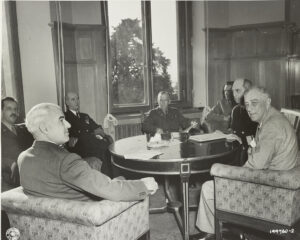
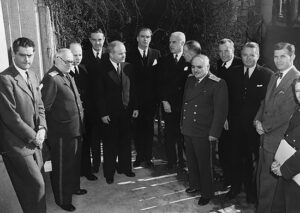 on Yalta, he was no longer strong enough to stand with the support of braces. In that speech, he called the conference ‘a turning point, I hope, in our history, and therefore in the history of the world.'” Unfortunately, he was too sick to recover now. Roosevelt did not live long enough to see the iron curtain drop along the lines of division laid out at Yalta. In April, he traveled to his cottage in Warm Springs, Georgia, to rest and on April 12 died of a cerebral hemorrhage.
on Yalta, he was no longer strong enough to stand with the support of braces. In that speech, he called the conference ‘a turning point, I hope, in our history, and therefore in the history of the world.'” Unfortunately, he was too sick to recover now. Roosevelt did not live long enough to see the iron curtain drop along the lines of division laid out at Yalta. In April, he traveled to his cottage in Warm Springs, Georgia, to rest and on April 12 died of a cerebral hemorrhage.

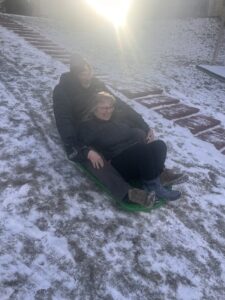 My sister, Allyn Hadlock, better known as Grammy. That name probably started out as just the grandkids, but as any grandparent knows, sooner or later, your kids call you that too, so their kids know who they are talking about. So, now, that is probably what more of them call her that. Her grandkids LOVE her. For Allyn, being “Grammy” is one of the most important aspects of her life. She loves to spend time with her grandkids, and if they live too far away, she visits or calls them. She is a hands-on Grammy, even if she is far away. Every morning before she gets ready for her day, she makes time to talk to granddaughter, Mackenzie Moore on video. Mackenzie looks forward to their call each day.
My sister, Allyn Hadlock, better known as Grammy. That name probably started out as just the grandkids, but as any grandparent knows, sooner or later, your kids call you that too, so their kids know who they are talking about. So, now, that is probably what more of them call her that. Her grandkids LOVE her. For Allyn, being “Grammy” is one of the most important aspects of her life. She loves to spend time with her grandkids, and if they live too far away, she visits or calls them. She is a hands-on Grammy, even if she is far away. Every morning before she gets ready for her day, she makes time to talk to granddaughter, Mackenzie Moore on video. Mackenzie looks forward to their call each day.
Ally’s top priority in life is and always will be God. She is a spiritual leader in her family…always leading through actions, words, and lots of love!! Allyn is very pure of heart. She has always served the Lord and works very hard to grow closer to Him every day. She devotes time 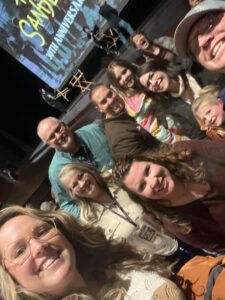
 to Bible study and worship every day. As her daughter, Lindsay says, “She is someone you can go to for prayer, advice, wisdom, questions, and know that she will help you find the answer or lead you towards Jesus. She’s such a GREAT and wonderful mom, uniquely equipped to mother and grandmother, called by God for something special!!” And in Lindsay style, “I’m obviously her favorite child.” Hahahahaha!! Ok, Lindsay, we will take your word for it.
to Bible study and worship every day. As her daughter, Lindsay says, “She is someone you can go to for prayer, advice, wisdom, questions, and know that she will help you find the answer or lead you towards Jesus. She’s such a GREAT and wonderful mom, uniquely equipped to mother and grandmother, called by God for something special!!” And in Lindsay style, “I’m obviously her favorite child.” Hahahahaha!! Ok, Lindsay, we will take your word for it.
Allyn works from home now, and really loves it. Allyn and her husband, Chris had their house built on his parents land east of town but the Platte River. They love it there. They feel totally at peace, and they love having gatherings and parties there too. So, it totally stands to reason that Allyn would be so happy to work from home now. It is her happy place. She is at peace there, and it puts a song in her heart. I can’t imagine a place that better suits my little sister. I’m sure that when she takes a break from work, and goes downstairs for 
 a cup of coffee, her eyes are drawn to the river slowly going by out back…unless it’s frozen over, of course. There are turkeys that hang out back there, and a number of other critters. Everything from deer, to foxes, to all kinds of rodents scurry around her place. I suppose they are preparing for winter, or maybe just hanging out, but they obviously love her place just as much as she does. That is so cool. Today is Allyn’s birthday. Happy birthday Allyn!! Have a great day!! We love you!!
a cup of coffee, her eyes are drawn to the river slowly going by out back…unless it’s frozen over, of course. There are turkeys that hang out back there, and a number of other critters. Everything from deer, to foxes, to all kinds of rodents scurry around her place. I suppose they are preparing for winter, or maybe just hanging out, but they obviously love her place just as much as she does. That is so cool. Today is Allyn’s birthday. Happy birthday Allyn!! Have a great day!! We love you!!

 My nephew, Jake Harman has been a very busy guy this year. There are a lot of changes going on. Jake has wanted to get his Class A CDL license, and this was his year. Now he has a new job with Meyer’s Logistics, as a delivery driver, that has him traveling from Casper to South Dakota, which for our family is a favorite place…and also to Nebraska and around Wyoming. Jake has been heading for a job like this for a long time. Prior to this, he has been a bus driver for the schools and the city busses. He loved his jobs, and the people he drove to their destinations, but he needed something more. Some people just have a call to the open road.
My nephew, Jake Harman has been a very busy guy this year. There are a lot of changes going on. Jake has wanted to get his Class A CDL license, and this was his year. Now he has a new job with Meyer’s Logistics, as a delivery driver, that has him traveling from Casper to South Dakota, which for our family is a favorite place…and also to Nebraska and around Wyoming. Jake has been heading for a job like this for a long time. Prior to this, he has been a bus driver for the schools and the city busses. He loved his jobs, and the people he drove to their destinations, but he needed something more. Some people just have a call to the open road.
Jake’s wife, Melanie tells me, “He still is just the biggest goofball ever, but we all love it so much!!” Jake has an amazing imagination, and they decided to set up a Laser Beam Game for their kids, Alice, Izabella, and Jaxx in their hallway at home. Jake came up with the story line that was fantastic and his excitement and enthusiasm with it just made it so much better. So, as the story goes, “Mom (Melanie) was frozen by a monster which was 
 Dad (Jake) ha ha, and the only way to save Mom was for each of them to get down the hallway and back without getting hit by the lasers. Along the way, they had to find their one item to put on Mom to unfreeze her before the monster got them all! It was so much fun lol!!”
Dad (Jake) ha ha, and the only way to save Mom was for each of them to get down the hallway and back without getting hit by the lasers. Along the way, they had to find their one item to put on Mom to unfreeze her before the monster got them all! It was so much fun lol!!”
All of his babies absolutely love him and his energy!! I think that because Jake is mostly a kid himself, he can totally relate to his children. Their home is filled with laughter, excitement, and amazing playtime. Jake is an amazing dad and loving husband. He is one of those husband’s that never forget to let his wife know what a blessing she is to him. He is always telling Melanie how beautiful she is and sending her texts saying, “You are God given, life without you is life not worth living.” Melane says, “It melts my heart Every time!!” Melanie has been struggling with some depression issues lately, and Jake has been amazing at helping her try to get through…doing whatever he can to help right now.

 Jake loves his baby sister, Siara so much and her husband, Chris along with their new baby Nathan (Nathaniel). He is so happy to have this new nephew in his life. Jake’s kids, wife, and his sister’s little family are by far his best friends!! He would do anything for any of his family…no matter who it is!! And anyone who knows Jake very well, knows just how true that statement is. Jake is a giver and a helper, and he has a loving heart that is as big as the great outdoors. Today is Jake’s birthday. Happy birthday Jake!! Have a great day!! We love you!!
Jake loves his baby sister, Siara so much and her husband, Chris along with their new baby Nathan (Nathaniel). He is so happy to have this new nephew in his life. Jake’s kids, wife, and his sister’s little family are by far his best friends!! He would do anything for any of his family…no matter who it is!! And anyone who knows Jake very well, knows just how true that statement is. Jake is a giver and a helper, and he has a loving heart that is as big as the great outdoors. Today is Jake’s birthday. Happy birthday Jake!! Have a great day!! We love you!!
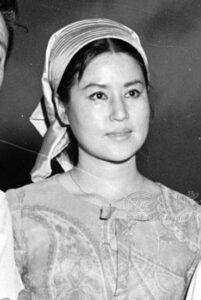 It is no secret that dictators do as they please, and they don’t care what anyone around them thinks of what they do. That is why so many people try to escape the countries run by a dictator. The things they do are often violent and horrific, but sometimes they can be totally bizarre too. One of the strangest acts was performed not by Kim il-Sung, who was dictator in 1978, but rather by his son, Kim Jong-il, who assumed, and rightly so, that he could also do what he wanted to. Kim Jong-il was a film buff, as well as the future North Korean dictator. Kim Jong-il decided that he wanted to make a really good movie. As any director knows, in order to make a really good movie, one must have a really good actor. Kim Jong-il knew exactly who he wanted, but rather than be bothered by the process of hiring the best actor, he simply kidnapped the one he wanted…Choi Eun-hee, as well as her ex-husband, director Shin Sang-ok. Kim Jong-il kept the pair in North Korea for several years, forcing them to make movies, including his very own version of Godzilla, Pulgasari. They now had no choice but to comply with his wishes, or they would die.
It is no secret that dictators do as they please, and they don’t care what anyone around them thinks of what they do. That is why so many people try to escape the countries run by a dictator. The things they do are often violent and horrific, but sometimes they can be totally bizarre too. One of the strangest acts was performed not by Kim il-Sung, who was dictator in 1978, but rather by his son, Kim Jong-il, who assumed, and rightly so, that he could also do what he wanted to. Kim Jong-il was a film buff, as well as the future North Korean dictator. Kim Jong-il decided that he wanted to make a really good movie. As any director knows, in order to make a really good movie, one must have a really good actor. Kim Jong-il knew exactly who he wanted, but rather than be bothered by the process of hiring the best actor, he simply kidnapped the one he wanted…Choi Eun-hee, as well as her ex-husband, director Shin Sang-ok. Kim Jong-il kept the pair in North Korea for several years, forcing them to make movies, including his very own version of Godzilla, Pulgasari. They now had no choice but to comply with his wishes, or they would die.
Choi was born in Gwangju, Gyeonggi Province, in 1926. Her first acting role was in the 1947 film “A New Oath.” She rose to fame the following year after starring in the 1948 film “The Sun of Night” 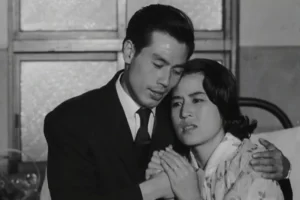 and soon became known as one of the “troika” of Korean film, alongside actresses Kim Ji-mee and Um Aing-ran. She later married the director Shin Sang-ok in 1954, the two founded Shin Film. Her career flourished, and she went on to act in over 130 films. She was considered one of the biggest stars of South Korean film in the 1960s and 1970s. Due to her fame, she starred in many of Shin’s iconic films including 1958’s “A Flower in Hell” and 1961’s “The Houseguest and My Mother.” he one sadness in their lives was that she could not have children, so the couple adopted two children together, Jeong-kyun and Myung-kim. Choi divorced Shin after hearing that he had fathered two children with a young actress.
and soon became known as one of the “troika” of Korean film, alongside actresses Kim Ji-mee and Um Aing-ran. She later married the director Shin Sang-ok in 1954, the two founded Shin Film. Her career flourished, and she went on to act in over 130 films. She was considered one of the biggest stars of South Korean film in the 1960s and 1970s. Due to her fame, she starred in many of Shin’s iconic films including 1958’s “A Flower in Hell” and 1961’s “The Houseguest and My Mother.” he one sadness in their lives was that she could not have children, so the couple adopted two children together, Jeong-kyun and Myung-kim. Choi divorced Shin after hearing that he had fathered two children with a young actress.
Choi’s career began to suffer after her divorce, and she traveled to Hong Kong in 1978 to meet with a person 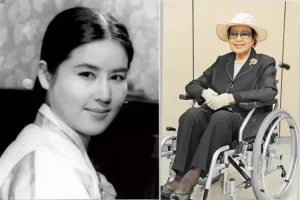 posing as a businessman who offered to set up a new film company with her. While she was in Hong Kong, Choi was abducted and taken to North Korea by the order of Kim Jong-il. Shin began a frantic search for Choi, but while searching for her, Shin was also abducted and taken to North Korea. So began years in captivity from which they finally escaped in 1986, during a press conference in Vienna!! They were in Vienna for a film festival. They fled to the US embassy and requested political asylum. Following their escape, they lived in Reston, Virginia, then Beverly Hills, California, before finally returning to South Korea in 1999. Choi died of kidney disease April 16, 2018. She was 91.
posing as a businessman who offered to set up a new film company with her. While she was in Hong Kong, Choi was abducted and taken to North Korea by the order of Kim Jong-il. Shin began a frantic search for Choi, but while searching for her, Shin was also abducted and taken to North Korea. So began years in captivity from which they finally escaped in 1986, during a press conference in Vienna!! They were in Vienna for a film festival. They fled to the US embassy and requested political asylum. Following their escape, they lived in Reston, Virginia, then Beverly Hills, California, before finally returning to South Korea in 1999. Choi died of kidney disease April 16, 2018. She was 91.
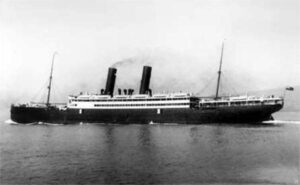 The SS California, owned by Anchor Line Steamship Company; a Scottish merchant shipping company that was founded in 1855 and dissolved in 1980; departed New York on January 29, 1917, bound for Glasgow, Scotland, with 205 passengers and crewmembers on board. While the trip should have been a pleasant journey, world events would soon happen that would change everything in an instant. On February 3, 1917, United States President Woodrow Wilson gave a speech in which he “broke diplomatic relations with Germany and warned that war would follow if American interests at sea were again assaulted.” Of course, all ship sailing the seas, especially those departing or arriving in the United States, or any that had US passengers were warned about the possibility of a German attack.
The SS California, owned by Anchor Line Steamship Company; a Scottish merchant shipping company that was founded in 1855 and dissolved in 1980; departed New York on January 29, 1917, bound for Glasgow, Scotland, with 205 passengers and crewmembers on board. While the trip should have been a pleasant journey, world events would soon happen that would change everything in an instant. On February 3, 1917, United States President Woodrow Wilson gave a speech in which he “broke diplomatic relations with Germany and warned that war would follow if American interests at sea were again assaulted.” Of course, all ship sailing the seas, especially those departing or arriving in the United States, or any that had US passengers were warned about the possibility of a German attack.
February 7, 1917, found the SS California some 38 miles off the coast of Fastnet, Ireland, when the ship’s captain, John Henderson, spotted a submarine off his ship’s port side at a little after 9am. I can only imagine the sinking feeling the captain must have felt at that moment. The Germans were not known for any kind of compassion, and they didn’t particularly care if this was a passenger ship. They figured that the ship might be carrying weapons, and they actually might have been. Captain Henderson ordered the gunner at the stern of the ship to fire in defense, if necessary. Unfortunately, there would not be time to do so, because moments later and without warning, the submarine fired two torpedoes at the ship. The first torpedo missed, but the second torpedo exploded into the port side of the steamer, killing five people instantly. The explosion of that torpedo was so violent and devastating that it caused the 470-foot, 9,000-ton steamer to sink just nine minutes later. The crew quickly sent desperate S.O.S. calls, but the best they could hope for was a hasty arrival of rescue ships. Time was simply not on their side, as 38 people drowned after the initial explosion, and with the initial 5 who died when the torpedo impacted the ship, a total of 43 died. It was an act of war by the Germans.
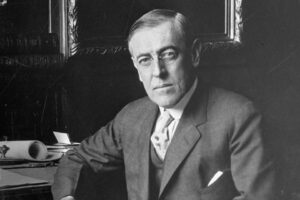 The Germans were known for this type of blatant attack, in complete defiance of Wilson’s warnings. It’s almost as if they were simply crazed with hatred. Because of Wilson’s warnings about the consequences of unrestricted submarine warfare and the subsequent discovery and release of the Zimmermann telegram, the Germans reached out to the foreign minister to the Mexican government involving a possible Mexican-German alliance in the event of a war between Germany and the United States. That caused Wilson and the United States to take the final steps towards war. On April 2, 1917, Wilson delivered his war message before Congress. It was this action that brought about the United States’ entrance into the First World War, which came about just four days later.
The Germans were known for this type of blatant attack, in complete defiance of Wilson’s warnings. It’s almost as if they were simply crazed with hatred. Because of Wilson’s warnings about the consequences of unrestricted submarine warfare and the subsequent discovery and release of the Zimmermann telegram, the Germans reached out to the foreign minister to the Mexican government involving a possible Mexican-German alliance in the event of a war between Germany and the United States. That caused Wilson and the United States to take the final steps towards war. On April 2, 1917, Wilson delivered his war message before Congress. It was this action that brought about the United States’ entrance into the First World War, which came about just four days later.

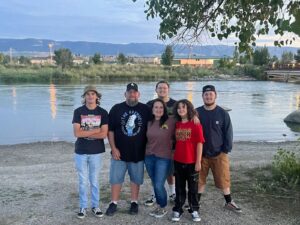 My niece, Jenny Masterson is a woman of many talents. As many people know, she is a natural-born hostess. She loves to entertain. That is a rare talent. Most of us get stressed out when we have to host holidays, birthdays, or parties. It’s not that we don’t enjoy having the party, but rather that some of us are great at it and others of us simply throw it together. In reality, many of us would much rather have Jenny plan and execute the party and let us take the credit for it. Jenny is a natural, and her parties are fun. Jenny’s favorite parties are the holidays with family. That stands to reason, because Jenny is all about family. She loves them all.
My niece, Jenny Masterson is a woman of many talents. As many people know, she is a natural-born hostess. She loves to entertain. That is a rare talent. Most of us get stressed out when we have to host holidays, birthdays, or parties. It’s not that we don’t enjoy having the party, but rather that some of us are great at it and others of us simply throw it together. In reality, many of us would much rather have Jenny plan and execute the party and let us take the credit for it. Jenny is a natural, and her parties are fun. Jenny’s favorite parties are the holidays with family. That stands to reason, because Jenny is all about family. She loves them all.

 Jenny also loves to hike the mountains, and since my niece, her cousin Andrea Beach moved back to Casper from Rawlins, she and Jenny have been doing a lot of hiking, even in the winter. Of course, you can’t hike some of the tougher trails in the winter, but they do what they can, in anticipation of the summer hiking season to come. The truth is that these two girls have really become close. They do a lot of things together, and they spend time talking, and just enjoying each other’s company. It’s been a really good thing for both of them. They are both social people, and it’s always nice to have a “bestie” to share things with. They have both been a blessing to each other. Jenny also loves taking her other hiking buddy along too. Bella the dog is always ready to go with the girls and the famiy on the next hiking adventure.
Jenny also loves to hike the mountains, and since my niece, her cousin Andrea Beach moved back to Casper from Rawlins, she and Jenny have been doing a lot of hiking, even in the winter. Of course, you can’t hike some of the tougher trails in the winter, but they do what they can, in anticipation of the summer hiking season to come. The truth is that these two girls have really become close. They do a lot of things together, and they spend time talking, and just enjoying each other’s company. It’s been a really good thing for both of them. They are both social people, and it’s always nice to have a “bestie” to share things with. They have both been a blessing to each other. Jenny also loves taking her other hiking buddy along too. Bella the dog is always ready to go with the girls and the famiy on the next hiking adventure.
Of course, Jenny’s main “bestie” is her husband, Steve Spethman. They have been madly in love since the day they met some 22+ years ago. They are perfect for each other. They have like values and like interests. They 
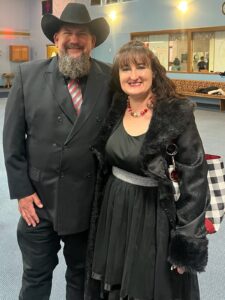 love to travel and see new things. They love their family and watching their children grow up. They love God, and they love growing in faith every day. They stand by each other in good times and in bad times. Each of them knows that the other is there for them and will support them no matter what. They are totally committed to each other, totally happy, and they are best friends. Life just doesn’t get better than that, does it? Today is Jenny’s birthday. Happy birthday Jenny!! Have a great day!! We love you!!
love to travel and see new things. They love their family and watching their children grow up. They love God, and they love growing in faith every day. They stand by each other in good times and in bad times. Each of them knows that the other is there for them and will support them no matter what. They are totally committed to each other, totally happy, and they are best friends. Life just doesn’t get better than that, does it? Today is Jenny’s birthday. Happy birthday Jenny!! Have a great day!! We love you!!
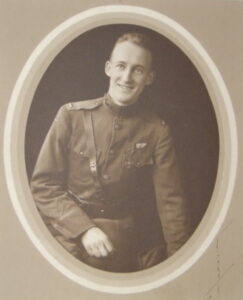 In World War I, airplanes were a relatively new item. The Wright brothers made their first sustained flight on December 17, 1903, so by 1918, they were still barely more than a novelty, but that didn’t matter. The world needed these machines, if the Allied countries were to win World War I. I’m sure that no one really knew how these new machines were going to work out, and I can only imagine how the pilots that had to fly those first planes felt about not only flying in them, but doing combat in them. One of those first crew members was Stephen W Thompson, a 24-year-old gunner on a French aircraft in February 1918.
In World War I, airplanes were a relatively new item. The Wright brothers made their first sustained flight on December 17, 1903, so by 1918, they were still barely more than a novelty, but that didn’t matter. The world needed these machines, if the Allied countries were to win World War I. I’m sure that no one really knew how these new machines were going to work out, and I can only imagine how the pilots that had to fly those first planes felt about not only flying in them, but doing combat in them. One of those first crew members was Stephen W Thompson, a 24-year-old gunner on a French aircraft in February 1918.
Thompson was born on March 20, 1894, in West Plains, Missouri. When the United States entered World War I in April 1917, Thompson was a senior in electrical engineering at the University of Missouri. Men were needed to go and fight, so the school announced that seniors who joined the military before graduation would receive their diplomas in June. Being a loyal American, Thompson enlisted in the Army. He was sent for basic training at Fort Riley, Kansas, and by June he was sent to Fort Monroe, Virginia for training in the Coast Artillery Corps. The train ride to his post would change his life forever, when he spotted an airplane in the sky. It was the first one he had ever seen, and when he got the opportunity, he went to the flying field, the Curtis School at Newport News, and asked if he could take a ride. He figured it might be the only chance he would get, and he didn’t want to miss out. Thomas Scott Baldwin, who had been a famous performer in his own balloons and dirigibles, was in charge and he agreed to give Thompson a ride. The plane 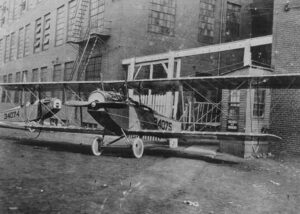 was a Curtiss JN-4 Jenny and the pilot was Edward Stinson, a prominent flyer at the time who later founded the Stinson Aircraft Company.
was a Curtiss JN-4 Jenny and the pilot was Edward Stinson, a prominent flyer at the time who later founded the Stinson Aircraft Company.
After his ride, in which Stinson did a number of aerobatic maneuvers, including looping the loop five times in a row, Thompson said that the only thing that kept him from falling out of the plane at the top of the last loop was the lap belt. I can only imagine how he felt, but that flight changed Thompson’s whole life. He decided to apply for duty in the Air Service. He was accepted, and on February 5, 1918, flying as a gunner on a French aircraft in February 1918, he became the first member of the United States military to shoot down an enemy aircraft. He was not the first person to shoot down another aircraft, because Kiffin Rockwell achieved an earlier aerial victory as an American volunteer member of the French Lafayette Escadrille in 1916. Nevertheless, Thompson was the first “official soldier” to do so. That day, the 1st Aero Squadron had not yet begun combat operations, and Thompson visited a French unit with a fellow member of the 1st Aero Squadron. The men were invited to fly as gunner-bombardiers with the French on a bombing raid over Saarbrücken, Germany. Well, nobody had to ask them twice. The run was successful, but after they had dropped their bombs, the squadron was attacked by Albatros D III fighters. Immediately taking action, Thompson shot down one of them, thereby 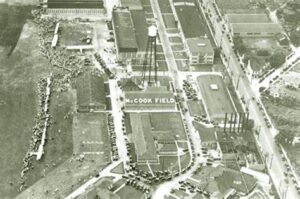 carrying out the first aerial victory by any member of the US military. He was awarded the Croix de Guerre with Palm for the action.
carrying out the first aerial victory by any member of the US military. He was awarded the Croix de Guerre with Palm for the action.
After the war Thompson worked at McCook Field for several years as an engineer. Today, McCook Field is Wright-Patterson Air Force Base. Following his time at McCook Field, he became a high school mathematics teacher. During World War II, he taught preflight and meteorology. He maintained an interest in aviation and in 1940 he received US Patent Number 2,210,642 for a tailless flying wing. He died on October 9, 1977, in Dayton, Ohio at age 83.
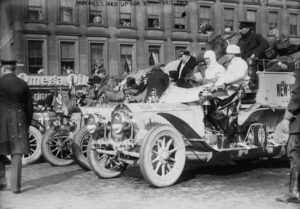
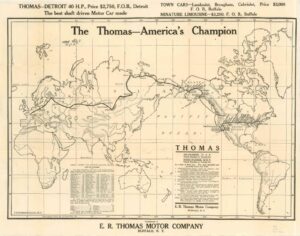 A car race is most often run on a track, with lots of fans cheering everyone on, but in 1908, there was a very strange car race that actually used a track that took the drivers around the world!! How…you might ask?? Well, the car race started in New York City. From there the route took the racers to San Francisco. Normally, San Francisco would be the end of the trail…or the route. You would have reached the Pacific Ocean, and as we all know, cars can’t drive on the ocean…especially cars manufactured in 1908. So, the racers turned to the north and headed for Valdez, Alaska. They would arrive in Valdez in the height of winter…at a time when the Bering Strait was frozen over…theoretically. At that point there was supposed to be an ice bridge across the Bering Strait, making it possible for the cars to drive right over it and into Russia. Once across, the racers would continue on from Russia to Europe and the finish line awaiting them in Paris. It’s amazing to me to think about cars being driven around the world, but of course the Bering Strait in the Winter, supposedly changed everything. In 1908, cars were relatively new, so road infrastructure was limited to only metropolitan areas, and even then, a lot of it was cobbled stone. So, I suppose cross country car travel on dirt trails was not that uncommon.
A car race is most often run on a track, with lots of fans cheering everyone on, but in 1908, there was a very strange car race that actually used a track that took the drivers around the world!! How…you might ask?? Well, the car race started in New York City. From there the route took the racers to San Francisco. Normally, San Francisco would be the end of the trail…or the route. You would have reached the Pacific Ocean, and as we all know, cars can’t drive on the ocean…especially cars manufactured in 1908. So, the racers turned to the north and headed for Valdez, Alaska. They would arrive in Valdez in the height of winter…at a time when the Bering Strait was frozen over…theoretically. At that point there was supposed to be an ice bridge across the Bering Strait, making it possible for the cars to drive right over it and into Russia. Once across, the racers would continue on from Russia to Europe and the finish line awaiting them in Paris. It’s amazing to me to think about cars being driven around the world, but of course the Bering Strait in the Winter, supposedly changed everything. In 1908, cars were relatively new, so road infrastructure was limited to only metropolitan areas, and even then, a lot of it was cobbled stone. So, I suppose cross country car travel on dirt trails was not that uncommon.
The Great Race of 1908 began on February 3rd of that year and immediately ran into challenges. Just to list a few…cars breaking down multiple times, lack of usable roads, car-hating people giving wrong directions, and, oh yeah, SNOW!!! Nevertheless, the teams persevered, and the first team reached San Francisco in 41 days. The came the obstacle of the fact that the proposed route from San Francisco to Alaska did not exist. I guess that they didn’t think it would be feasible to create the route, so the race organizers allowed teams to ship their cars to Valdez, Alaska, then continue on the Ice Bridge. Some might have called that a bit of a cheat, but I guess if all the racers id it, it wasn’t really cheating. Once in Valdez, the teams found out that there is, in fact, no ice bridge across the Bering Strait anymore, because it melted about 20,000 YEARS AGO. Oops…small oversight. So, the racers were allowed to ship their cars across the Pacific to Japan, then Russia, to carry on. Ok, if you’re like me, at this point, you are starting to see that this race had a lot of flaws in the planning. And honestly, while I knew there was no ice bridge on the Bering Strait today, I was unaware that it melted that long ago…meaning there was not an ice bridge since the “Ice Age!!”
So, was this really a car race around the world or a whole lot of non-sense. To be sure, the six teams did end up in Paris after the race, and they drove all of the route that could be driven, but the reality is that much of the race was simply cars being transported by ships across the ocean. Nevertheless, the “official” race was documented as just that…a car race that went around the world. The cars had to fight mud, snow, and mechanical problems. It was “officially” won by The Thomas Flyer, built by the Thomas Motor Company, was a 1907 Model 35 with a 4-cylinder, 60-horsepower engine capable of reaching 60 mph. It was fully loaded with two shovels, two picks, two lanterns, eight searchlights, two extra gas tanks (with a capacity of ten gallons), five hundred feet of rope, a rifle and revolvers. It was also equipped with an attachable top…much like those used on covered wagons…that could wrap the entire car and offer an enclosed place to sleep. On July 30, after 169 days of travel, the Thomas car entered Paris. Even in Paris, they almost didn’t finish, because a police 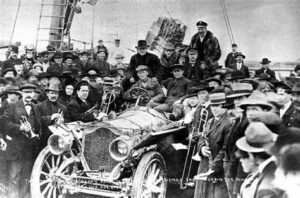
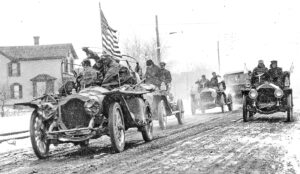 officer stopped the vehicle, saying it had no working headlight, and couldn’t proceed. A passing bicyclist witnessed the scene and offered to load his bike into the car. Since the bicycle had a working headlight, the officer allowed them to pass. The Thomas Flyer finally finished at 6:00pm. The race was the only “official” car race around the world.
officer stopped the vehicle, saying it had no working headlight, and couldn’t proceed. A passing bicyclist witnessed the scene and offered to load his bike into the car. Since the bicycle had a working headlight, the officer allowed them to pass. The Thomas Flyer finally finished at 6:00pm. The race was the only “official” car race around the world.

 My nephew, Dave Chase loves life, and he likes to live it big. That said, this year was apparently slow, but good. I love hearing about all the adventures Dave and my niece, Toni Chase go on. They do some of the coolest things. This year, Dave stayed true to his usual, consistent self, with lots of travel, including his yearly trip to the NCAA men’s basketball tournament in Colorado last March, then squeezing in some skiing on the way home. Dave loves all sports, and so he made countless fishing trips, stayed active in basketball, softball, golf (indoor and outdoor), aa well as, cribbage. He also went to Laramie for several football and basketball games. Dave likes to stay busy and connected to the world of sports. It’s just in his nature.
My nephew, Dave Chase loves life, and he likes to live it big. That said, this year was apparently slow, but good. I love hearing about all the adventures Dave and my niece, Toni Chase go on. They do some of the coolest things. This year, Dave stayed true to his usual, consistent self, with lots of travel, including his yearly trip to the NCAA men’s basketball tournament in Colorado last March, then squeezing in some skiing on the way home. Dave loves all sports, and so he made countless fishing trips, stayed active in basketball, softball, golf (indoor and outdoor), aa well as, cribbage. He also went to Laramie for several football and basketball games. Dave likes to stay busy and connected to the world of sports. It’s just in his nature.
While Dave might be totally connected to the sports, his family takes priority over even that. He and Toni make several trips each tear to Centennial to see his mom, and the rest of the Chase clan. It’s always a great time. The most “memorable” of the Centennial excursions was when Dave decided that he, his little brother Dan, his little sister Jane, Toni, and their pups, Biscuit and Cricket should all make a trip on the back roads from Laramie to Centennial to Steamboat Colorado to look at the changing colors of the leaves. For Dave and his brother, who have the nice comfortable front seats with lots of legroom, the trip was great. The girls and the pups were relegated to the back seats, and it was a bit different. Toni tells me that she, Jane, and the pups were “crammed in the backseat for 7 hours on the bumpy back roads from Laramie, Wyoming through Walden, Colorado over Rabbit Ears Pass to Steamboat Springs and then back through Steamboat Springs via Hogs Park Reservoir (Medicine Bow National Forest) to Centennial, Wyoming. While that trip was a bit of a trial for Toni 
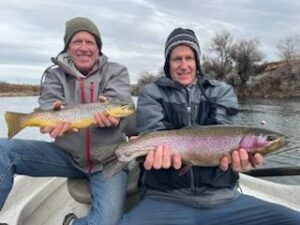 (only because of the long drive and now because of the family, whom Toni loves), Dave has always taken her on some really nice trips as a couple too. This year, as a way to get away, they went to Marco Island, Florida for some relaxation and fun in the sun.
(only because of the long drive and now because of the family, whom Toni loves), Dave has always taken her on some really nice trips as a couple too. This year, as a way to get away, they went to Marco Island, Florida for some relaxation and fun in the sun.
The fact is that Dave never stops!! And that’s a good thing. It keeps him young, and as anyone who knows Dave will tell you, he is very much a big kid!! He is also an inspiration and a motivation to anybody he comes into contact with!! Dave is nothing is not consistent, and that consistency is not only one of his many great qualities, but one of Toni’s favorites. It gives their lives stability, and it is something Toni can always rely on. She says that it is very comforting. Toni is so impressed with Dave’s consistency, that she took time to look up some synonyms of the word. Synonyms of consistent are “reliable, trustworthy, unfailing, dependable, and harmonious.” How very much perfect those words are for Dave. While that may seem boring to some people, Toni says, “They obviously haven’t met Dave.” I would have to agree with her, Dave is anything but boring. Instead, he is, absolutely dependable, reliable, and trustworthy. In fact, Toni says, “Harmonious is his middle name!! and as for Dave being ‘unfailing,’ well…just ask him.”
Dave has been a loyal employee, of the Bureau of Land Management, for almost 40 years…just 17 days shy of said anniversary…another way his consistency shows. Dave works as a petroleum engineer and as Supervisory Petroleum Engineer for the last 15 years. On December 26, 2023, Dave was granted The Superior Service Award of The Department of the Interior. He also won the Club Championship for Casper Cribbage in May. And on a funny side note, Toni sent me this funny story. “Sandy one of the ladies that Dave works with said that she 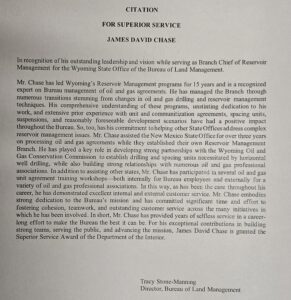
 had this picture from a day when Dave jumped in this new three-wheeler, because he thought it belonged to one of the girls they work with new. As it turns out, it belonged to the district manager…and to top it off, it was actually his wife’s, and she had said that he could never drive it…and then Dave just goes and jumps in it!!” Dave was in the driver’s seat before the district manager got to be there. Somebody is going to be in trouble!! Today is Dave’s birthday. Happy birthday Dave!! Have a great day!! We love you!!
had this picture from a day when Dave jumped in this new three-wheeler, because he thought it belonged to one of the girls they work with new. As it turns out, it belonged to the district manager…and to top it off, it was actually his wife’s, and she had said that he could never drive it…and then Dave just goes and jumps in it!!” Dave was in the driver’s seat before the district manager got to be there. Somebody is going to be in trouble!! Today is Dave’s birthday. Happy birthday Dave!! Have a great day!! We love you!!

